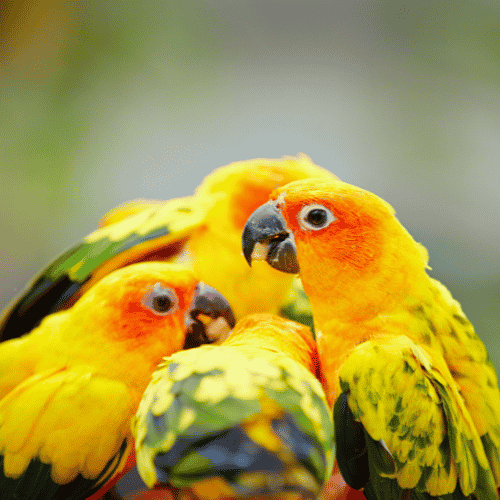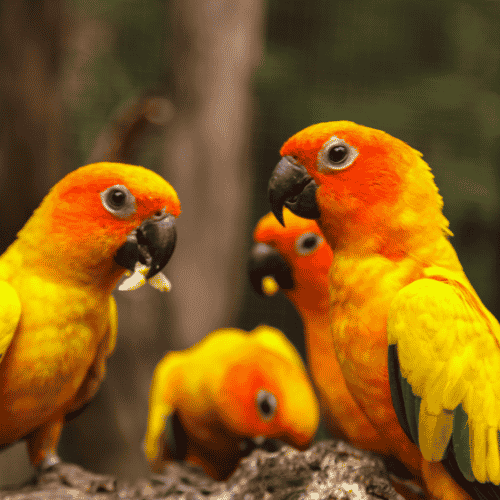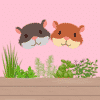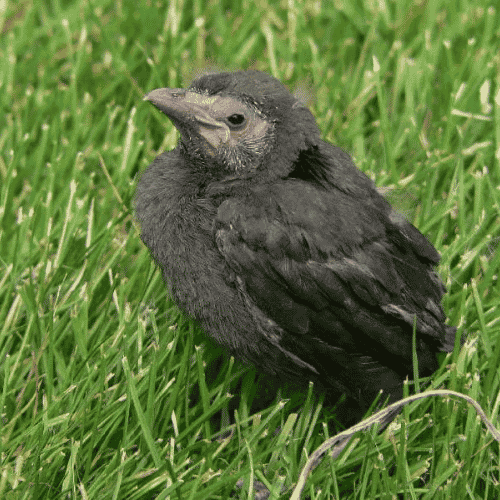Conures are highly intelligent and social birds, they use a variety of body language cues to communicate with each other as well as with us. While wing flapping is a normal method of stretching and improving blood circulation to their wings, wing flipping can be a sign of distress.

Flipping is often an involuntary movement, wherein the wings are held tightly and closer to the body. It might also be accompanied by a sound similar to popping. If the wing-flipping is accompanied by drooping, it can be taken as a sure sign of sickness.
Why Do Budgies Sing In Their Sleep? A Complete Guide
Understanding Conure Body Language
Birds may not speak what they feel, but that does not necessarily mean that we cannot understand their feelings. Their body language and vocalizations can often be very telling,
Eyes
Unlike us humans, birds have the ability to enlarge and shrink their pupils at will, it’s called pinning. Conures can be seen pinning when they are focusing on an object of great interest, or when they are angry or frightened.
This is usually accompanied by other cues such as tail, posture, and sounds, which help better understand whether this is aggression or just excitement.
Vocalizations
Birds make many different kinds of sounds to communicate, including calls for their mates, and another specific noise that is used to warn their kin of predators. They squawk or chirp or screech depending on their mood, and are among the most vocal creatures.
A happy conure can be found chirping merrily. At times it whistles to its owner—reminiscent of the call to its flock in the wild. Additionally, grunting can be either a sign of contentment, or unhappiness depending on other contextual cues, but rarely one of fear. However, screaming and screeching is a definite signs of aggression and fear.
Posture
A conure’s posture helps add a lot of important contexts to the other behaviors. For instance, if its head and body are held at a point of attention, the bird is happy and content; he or she is relaxed.
Similarly, if it crouches and bows its head for you, it is asking to be petted. On the other hand, if it bends its head, and raises its wings, it may be trying to attract a mate. However, if in addition to this, its feathers are flared, and its body feels rigid, it might be marking its territory.

If you are looking for cues of aggression, they include,
- Pinning of the eyes
- Tail feathers are flared
- Body feathers are ruffled
- Body is rigid
- Crest is raised
Beaks & Head
Conures use their beaks to feed themselves and their young, build their nest, and fend off predators. Beaks are more than just mouths; they are handy tools as well as a necessary weapons. They are also a good indicator of the bird’s mood and behavior. For instance, if it is grinding its beak, then the bird is content.

Similarly, if the bird clicks once and pins her eyes (with no other threatening signs), she is greeting you. However, if she clicks several times, it is a warning. Moreover, an open beak held in a crouching position, combined with a hissing sound is a tell-tale sign of it going to bite.
Birds can often be found chewing on things. This is a source of entertainment for them. They also like to practice or condition their beaks. Similarly, birds, especially conures, also play by grabbing each other’s beaks and wrestling. This is known as mouthing. Additionally, among birds, regurgitating with their head bobbing and eyes pinning is a sign of bonding and affection.
Do Birds Kiss – Bird Behavior Explained
Tails & Feathers
Birds, like other animals, use their tails to communicate. If your bird is flipping her tail, she’s really happy. Similarly, tail-wagging too is a sign that she is glad to see you. Nonetheless, it can also be a signal before defecation. However, tail-fanning is a sign of aggression or anger. It is considered a display of the bird’s strength and prowess.
If you find your conure rapidly breathing while bobbing its tail, it is just trying to catch its breath after some strenuous activity, or exercise. However, seek help if the bird exhibits this sign without any activity, it could be a symptom of respiratory illness.
As for feathers, birds ruffle their feathers mostly as part of the preening process. Moreover, they can be found quivering if they are scared or too excited. It is also often a part of their breeding behavior.
Why Do Birds Twitch Their Wings?
Wings are another great exhibitor of body language when it comes to birds. Wing twitching, however, has interpretations ranging from the reproductive drive to a symptom of major illness.
Young birds often twitch their wings to signal their parents that it’s time for food. This is commonly found among fledglings. Birds also twitch as part of molting. This is done to cope with the irritation and itchiness that is often present while they replace their old plumage with a brand new one.
Twitching is also a common way for birds, especially parrots, to attract their mate. However, it can also be a symptom of brain seizure or a viral infection. You need to look out for other symptoms and reach out to the vet accordingly.
Sun Conure Wing Twitching – What It Means?
If your sun conure is bobbing its head and twitching its head, it wants your attention. Additionally, if it is crouching and twitching, it’s the equivalent of a dog begging. It either wants to be let out, picked up, or is hungry and wants to be fed.
Conure Drooping Wings? Here’s What It Means
Wing drooping when accompanied by signs of weakness, like sitting at the bottom of the cage can be a symptom of an illness. Apart from that, birds may droop their wings to dry themselves too. Younger birds tend to droop their wings before learning how to properly fold and tuck them.
Conures droop their wings either as a sign of exhaustion or overheating, and can rarely be owing to depression, and aggression.
Key Takeaways
Conures are exciting birds, and any household fortunate enough to be graced by their presence will see plenty of liveliness and activity.
Watching them perform their antics is one of the best ways to kick back and relax, following a stressful day at work, and while it is normal for new owners to get anxious, you should get a better understanding of their behaviors, and body language over time.

Doctor of Veterinary Medicine (D.V.M.) at Nation Taiwan University,Master of Science (M.S.) in Biomedical Engineering at National Taiwan University of Science and Technology




